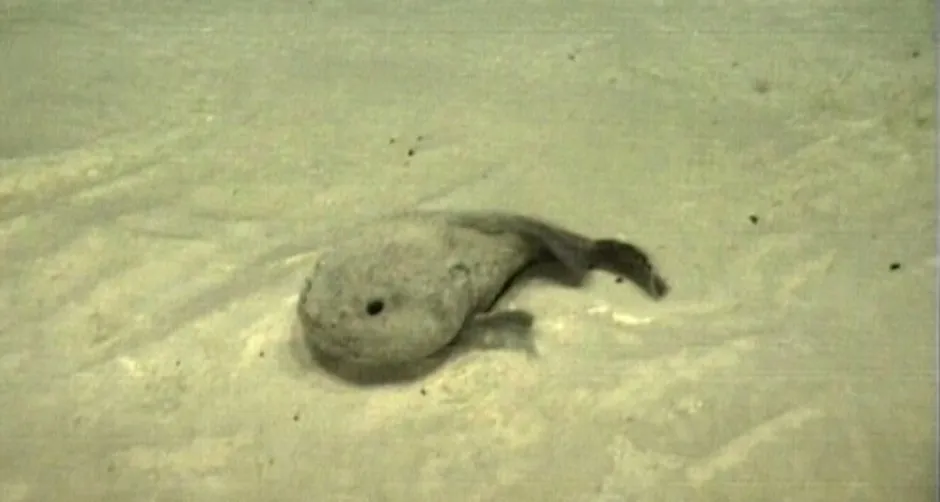Ah, the blobfish – the gelatinous-looking internet sensation that took the world by storm in 2003 due to its flabby face that’s equally intriguing, horrifying and hilarious.
Famous for its ugly headshots, his seemingly lazy bottom-feeding species is relatively new to science. However, it has cast its spell over humanity in the digital age and has already been immortalised in memes, soft toys and even an emoji.
The blobfish gained widespread fame after a specimen was photographed in 2003 – the famous image that caused its fame is the one you see at the top of the page.
Its odd-looking, slimy, gelatinous appearance made it a gift to early internet culture. Droopy, slimy and easy to anthropomorphise, the fish was named the ugliest animal in the world in a poll by the Ugly Animal Preservation Society.
It may have a face only a mother could love, but what do we actually know about this almost alien creature? Why does it look so glum? Ahat could it teach us about conservation or the secret world of the deep sea in which it lives? And what does it look like underwater.
Blobfish scientific name - Psychrolutes marcidus
The scientific name of the fish in the famous blobfish photo is Psychrolutes microporos, from a family of fish called Psychrolutidae. However, the term 'blobfish' is sometimes used more broadly to describe other members of the Psychrolutidae family such as Psychrolutes marcidus.
The first specimen of P. microporos was found by a research vessel off the coast of New Zealand in 1983. It was another decade before the fish was formally described and given its scientific name.
And even now, there are large gaps in our understanding of this enigmatic sea creature, despite a number of other samples being found in trawler nets.
The 2003 specimen was nicknamed Mr Blobby, after the British TV character.
What is a blobfish?
Before finding fame as an internet meme, the blobfish was a scientific curiosity. A member of the Psychrolutidae family, it is sometimes referred to as a sculpin or (for obvious reasons) fathead. The flabby appearance of this deep-sea fish celebrated in internet culture is, however, misleading.
The species only looks like a 1980s dessert when removed from its natural environment and brought to the surface.
Why do blobfish look like that?
Blobfish species live in some of the deepest pockets of the ocean, at depths between 600 and 1,200m. Down there, the pressure can be more than 100 times what the atmospheric pressure you feel right now. Blobfish have a variety of adaptations to live in high-pressure habitats, including a squishy body, with soft bones and very little muscle.
When a blobfish is taken out of water, decompression can make it expand and cause its skin to relax, distorting its features and giving it that characteristic big nose. And on land or the deck of a boat, the blobfish’s gelatinous tissue doesn't hold its structure, and the animal collapses into a shapeless mass much like a washed-up jellyfish.
"The image everyone knows about is really hideous because it's a dead one," says Simon Watt, the biologist, comedian and science communicator who set up the Ugly Animal Preservation Society. "In the wild, they're not exactly beauty kings or queens but they're not quite so depressed-looking."
It’s the same as if we did the reverse to humans, and we were suddenly dragged to a depth of 1,200m without any protective gear or breathing apparatus. We would look pretty disgusting too! Blobfish look different underwater because they’re not supposed to be on land.
What does a blobfish look like underwater?
At depth, a blobfish kind of just looks like a fish. They have slightly bulbous heads, pronounced black eyes and feathery pectoral fins. Their bodies, pinkish-grey in colour, taper to the tail a bit like a tadpole. Blobfish typically measure less than 30cm in length and weigh under 2kg.

Are blobfish dangerous?
No. Blobfish are less than 30cm long, have soft bodies and no teeth. It’s safe to say you could take one in a fight.
But the vast majority of people will never encounter a blobfish anyway, unless you’re lucky enough to see a dead specimen in a museum or a fishing net. These animals live deep in the ocean, so you need a submarine or submersible to find them alive.
In 2019, Daily Mail Australia reported that a man working in the Sydney Fish Markets ate a blobfish. He didn’t appear to suffer any ill effects.
While it’s unlikely that such a fish will ever become commercially available, even if it is safe to eat, the impact we are having on blobfish now by just accidentally catching them occasionally is unknown.
How do blobfish swim?
With as little effort as possible. Like a lot of deep-sea fish, the blobfish doesn't have a swim bladder, the air sac-style organ that helps fish closer to the surface control their buoyancy. If they did, they'd be crushed under the pressure. Instead, the fatty body composition of the blobfish comes into play. It's actually less dense than the water it lives in.
"If you think about how oil floats on water, it's a bit like that: having high fat content means it makes them more buoyant," says Watt. Blobfish simply bob along in the water or on the sea bed, staying largely still and using as little energy as possible.
"It's labour-saving," Watt says. "Being lazy is a survival strategy, and being fatty to help being lazy is a survival strategy." We can all relate to that, surely.
What do blobfish eat?
Given their inherent lethargy, blobfish are thought to eat whatever passes right in front of them. Their neutral buoyancy means the water carries them along. When small crustaceans, sea snails or other edible matter gets too close, they become dinner.
This lie-in-wait strategy is common among deep-sea predators.
Read more about the deep sea:
- Deep sea mining: new depths
- Ancient deep-sea bacteria revived after 100 million years
- Toxic mercury found at the ocean's deepest point
Where do blobfish live?
The Psychrolutidae family is fairly widespread with species found in the Atlantic, Pacific and Indian Oceans. However, some species of blobfish – including the one nicknamed Mr Blobby – are found in fairly small territories.
P. microporos (and its closely related cousin P. marcidus) live in the waters around and between Australia and New Zealand, always at depths greater than 500m.

Blobfish reproduction
Little is known about blobfish reproduction due to the difficulty in observing the creature in the dark-depths of the ocean. This includes mating behaviour, though marine biologists suggest that, given their limited movement, pairs must simply cling to each other.
Other Psychrolutidae species have been observed laying thousands of eggs, and researchers estimate that a single female blobfish could lay up to 100,000 eggs. Females tend to group together and lay eggs in close-together nests, all on rocky plateaus in the ocean depths, presumably for protection.
There are a number of fake pictures of baby blobfish online, but it’s not clear what they actually look like.
How long can a blobfish live?
This is a difficult question to answer as we know so little about these intriguing fish. However, we do know that marine fish that live in deep water tend to grow slowly, take a long time to reach maturity and have extended lifespans.
For example, the roughly rockfish, which lives at depths of 150 to 450 metres, can live for more than 200 years.
Blobfish threats
It’s unclear whether blobfish are endangered or not, partly due to it living in the hard-to-study alien world of the deep ocean. Scientists have yet to figure out how many there are, whether they are predated upon or if they’re affected by climate change or ocean acidification.
Despite this, they are likely threatened by human activity. Deep-sea fishing and bottom trawling have been found to threaten many deep-sea fish species, and it is likely the flabby fish of the oceans are part of this extensive list. There is a likelihood that they, as with many marine species, are being affected by warming ocean temperatures – being a cold water species, as our oceans warm, they may be experiencing its impacts.
"With the blobfish, it's questionable whether it's even endangered, but that's true of almost all fish," says Watt. "It's very hard to work out the territory of a fish. We do know that there's a risk from deep-sea trawlers."
If P. microporos is limited to Oceania, its numbers are unlikely to be huge, but neither are the number of trawlers in the region. Though they have been caught before, it’s hard to know how much damage the population suffers from fishing.
"We know that anything that lives in the deep tends to have long lives, so for example an orange roughy – which is a fish we do see on tables throughout Europe – reach maturity at around 30. Which means if you kill one now, it's 30 years before that population recovers."
The blobfish and conservation
Whether or not the blobfish itself is endangered, it has already done an effective job at raising awareness, thanks in no small part to Watt's poll of the world's ugliest animals and ongoing projects. Hisapproach to conservation is deliberately irreverent, but the comedy belies a serious point. His website states that invertebrates, for example, make up 79 per cent of animal life, but they are only covered in 11 per cent of conservation literature. Ugly animals are less likely to be researched, never mind protected.
The blobfish may be unfairly painted with the ugly brush, but it still works as an effective mascot for Watt's work.
"Conservation is so depressing that we needed a silly way of talking about it," he says. "The people who know the giant panda are already on board. The people who have the blobfish as their spirit animal were not being talked to."
About our expert, Simon Watt
Simon Watt is a biologist, presenter, science communicator and author. He founded the Ugly Animal Preservation Society to boost the profile of less-loveable creatures. He is the author of The Ugly Animals: We Can't All Be Pandas
Read more about conservation:

